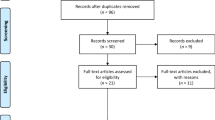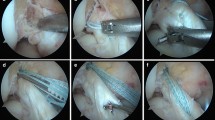Abstract
Purpose
To evaluate the effects of untreated stable ramp lesions on clinical and functional outcomes, return to sports rates, and complications of patients who underwent anterior cruciate ligament reconstruction.
Methods
A total of 879 patients with anterior cruciate ligament rupture were evaluated. Of these, 66 patients [33 patients with anterior cruciate ligament rupture and stable medial meniscal ramp lesion (ramp + group) and 33 patients with isolated anterior cruciate ligament rupture (ramp − group)] with a minimum 3-year of follow-up were included. Stable ramp lesions were not repaired in the ramp + group. Preoperative and postoperative Lachman and pivot-shift grades, Lysholm knee scores, International Knee Documentation Committee score and 12-Item Short Form Health Survey score were compared between groups. The return to sports rates, level of return to sports, time to return to sports and complications were compared.
Results
The mean patient age was 27.8 ± 7.2 years. The mean follow-up period was 47.3 ± 9.4 months. There were no significant differences between groups regarding preoperative and postoperative Lachman and pivot-shift grades, 12-Item Short Form Health Survey mental and physical component summary scores, Lysholm and International Knee Documentation Committee scores, and complication rates (n.s.). Although the return to sports rates (84.8% vs 90.1%) and the level of the return to sports (return to preinjury level: 75% vs 78%) were similar between groups (n.s.), the time to return to sports was significantly longer for patients with ramp lesions (11.1 ± 4.0 vs. 8.7 ± 2.5 months, p = 0.007).
Conclusion
Leaving the stable ramp lesion unrepaired does not negatively affect clinical and functional outcomes as well as return to sports rates after ACL reconstruction. However, the time to return to sports is prolonged in patients with ramp lesions In clinical practice, surgeons should be aware that repairing stable ramp lesions is not an absolute necessity and will not affect return to sport rates.
Level of evidence
Level III.



Similar content being viewed by others
References
Acosta J, Ravaei S, Brown SM, Mulcahey MK (2020) Examining techniques for treatment of medial meniscal ramp lesions during ACL reconstruction: a systematic review. Arthroscopy 36:2921–2933
Ahn JH, Wang JH, Yoo JC (2004) Arthroscopic all-inside suture repair of medial meniscus lesion in anterior cruciate ligament-deficient knees: results of second-look arthroscopies in 39 cases. Arthroscopy 20:936–945
Balazs GC, Greditzer HG, Wang D, Marom N, Potter HG, Rodeo SA et al (2020) Non-treatment of stable ramp lesions does not degrade clinical outcomes in the setting of primary ACL reconstruction. Knee Surg Sport Traumatol Arthrosc 28:3576–3586
Bumberger A, Koller U, Hofbauer M, Tiefenboeck TM, Hajdu S, Windhager R, Waldstein W (2020) Ramp lesions are frequently missed in ACL-deficient knees and should be repaired in case of instability. Knee Surg Sport Traumatol Arthrosc 28:840–854
Dephillipo NN, Cinque ME, Chahla J, Geeslin AG, Engebretsen L, Laprade RF (2017) Incidence and detection of meniscal ramp lesions on magnetic resonance imaging in patients with anterior cruciate ligament reconstruction. Am J Sports Med 45:2233–2237
DePhillipo NN, Dornan GJ, Dekker TJ, Aman ZS, Engebretsen L, LaPrade RF (2020) Clinical characteristics and outcomes after primary ACL reconstruction and meniscus ramp repair. Orthop J Sport Med 8:2325967120912427
DePhillipo NN, Engebretsen L, LaPrade RF (2019) Current trends among US surgeons in the identification, treatment, and time of repair for medial meniscal ramp lesions at the time of ACL surgery. Orthop J Sport Med 7:232596711982726
DePhillipo NN, Moatshe G, Brady A, Chahla J, Aman ZS, Dornan GJ, Nakama GY, Engebretsen L, LaPrade RF (2018) Effect of meniscocapsular and meniscotibial lesions in ACL-deficient and ACL-reconstructed knees: a biomechanical study. Am J Sports Med 46:2422–2431
Doral MN, Bilge O, Huri G, Turhan E, Verdonk R (2018) Modern treatment of meniscal tears. EFORT Open Rev 3:260–268
Di Francia R, Nicolas Q, Quintin-Roué I, Le Henaff G, Gunepin F-X, Dubrana F (2020) Ramp lesions of the posterior segment of the medial meniscus: What is repaired? A qualitative histological study of the meniscocapsular and meniscotibial attachments. Clin Orthop Relat Res. https://doi.org/10.1097/CORR.0000000000001536
Greif DN, Baraga MG, Rizzo MG, Mohile NV, Silva FD, Fox T, Jose J (2020) MRI appearance of the different meniscal ramp lesion types, with clinical and arthroscopic correlation. Skelet Radiol 49:677–689
Grindem H, Eitzen I, Engebretsen L, Snyder-Mackler L, Risberg MA (2014) Nonsurgical or surgical treatment of ACL injuries: knee function, sports participation, and knee reinjury: the Delaware-Oslo ACL Cohort Study. J Bone Jt Surg Am 96(15):1233
Guimaraes JB, Schwaiger BJ, Gersing AS, Neumann J, Facchetti L, Li X, Joseph GB, Link TM (2020) Meniscal ramp lesions: frequency, natural history, and the effect on knee cartilage over 2 years in subjects with anterior cruciate ligament tears. Skelet Radiol. https://doi.org/10.1007/s00256-020-03596-5
Gülenç B, Kemah B, Yalçın S, Sayar Ş, Korkmaz O, Erdil M (2020) Surgical treatment of meniscal ramp lesion. J Knee Surg 33(03):255–259
Hatayama K, Terauchi M, Saito K, Aoki J, Nonaka S, Higuchi H (2018) Magnetic resonance imaging diagnosis of medial meniscal ramp lesions in patients with anterior cruciate ligament injuries. Arthroscopy 34:1631–1637
Hatayama K, Terauchi M, Saito K, Takase R, Higuchi H (2020) Healing status of meniscal ramp lesion affects anterior knee stability after ACL reconstruction. Orthop J Sports Med 8:2325967120917674
Koo B, Lee SH, Yun SJ, Song JG (2019) Diagnostic performance of magnetic resonance imaging for detecting meniscal ramp lesions in patients with anterior cruciate ligament tears: a systematic review and meta-analysis. Am J Sports Med 48:2051–2059
Liu X, Feng H, Zhang H, Hong L, Wang XS, Zhang J (2011) Arthroscopic prevalence of ramp lesion in 868 patients with anterior cruciate ligament injury. Am J Sports Med 39:832–837
Liu X, Zhang H, Feng H, Hong L, Wang X, Song G (2017) Is it necessary to repair stable ramp lesions of the medial meniscus during anterior cruciate ligament reconstruction? A prospective randomized controlled trial. Am J Sports Med 45:1004–1011
Magosch A, Mouton C, Nührenbörger C, Seil R (2020) Medial meniscus ramp and lateral meniscus posterior root lesions are present in more than a third of primary and revision ACL reconstructions. Knee Surg Sports Traumatol Arthrosc. https://doi.org/10.1007/s00167-020-06352-3
Mouton C, Magosch A, Pape D, Hoffmann A, Nührenbörger C, Seil R (2019) Ramp lesions of the medial meniscus are associated with a higher grade of dynamic rotatory laxity in ACL-injured patients in comparison to patients with an isolated injury. Knee Surg Sports Traumatol Arthrosc 28:1023–1028
Nwachukwu BU, Chang B, Voleti PB, Berkanish P, Cohn MR, Altchek DW, Allen AA, Williams RJ (2017) Preoperative short form health survey score is predictive of return to play and minimal clinically important difference at a minimum 2-year follow-up after anterior cruciate ligament reconstruction. Am J Sports Med 45:2784–2790
Seil R, Mouton C, Coquay J, Hofmann A, Nührenbörger C, Pape D, Theisen D (2018) Ramp lesions associated with ACL injuries are more likely to be present in contact injuries and complete ACL tears. Knee Surg Sports Traumatol Arthrosc 26:1080–1085
Peltier A, Lording T, Maubisson L, Ballis R, Neyret P, Lustig S (2015) The role of the meniscotibial ligament in posteromedial rotational knee stability. Knee Surg Sport Traumatol Arthrosc 23:2967–2973
Stephen JM, Halewood C, Kittl C, Bollen SR, Williams A, Amis AA (2016) Posteromedial meniscocapsular lesions increase tibiofemoral joint laxity with anterior cruciate ligament deficiency, and their repair reduces laxity. Am J Sports Med 44:400–408
Tashiro Y, Mori T, Kawano T, Oniduka T, Arner JW, Fu FH, Iwamoto Y (2020) Meniscal ramp lesions should be considered in anterior cruciate ligament-injured knees, especially with larger instability or longer delay before surgery. Knee Surg Sport Traumatol Arthrosc 28:3569–3575
Thaunat M, Fayard JM, Guimaraes TM, Jan N, Murphy CG, Sonnery-Cottet B (2016) Classification and surgical repair of ramp lesions of the medial meniscus. Arthrosc Tech 5(4):e871–e875
Yagishita K, Muneta T, Ogiuchi T, Sekiya I, Shinomiya K (2004) Healing potential of meniscal tears without repair in knees with anterior cruciate ligament reconstruction. Am J Sports Med 32:1953–1961
Author information
Authors and Affiliations
Corresponding author
Ethics declarations
Conflict of interest
Kutalmis Albayrak, Mehmet Ozbey Buyukkuscu, Muhammed Bilal Kurk, Ozan Kaya, Ahmet Kulduk and Abdulhamit Misir declare that they have no conflict of interest.
Funding
This study received no specific grant from any funding agency in the public, commercial, or not-for-profit sectors.
Ethical approval
University of Health Sciences Baltalimani Bone Diseases Training and Research Hospital institutional review board approved the study protocol (no. 44/318).
Informed consent
An informed consent was obtained from all the patients.
Additional information
Publisher's Note
Springer Nature remains neutral with regard to jurisdictional claims in published maps and institutional affiliations.
Rights and permissions
About this article
Cite this article
Albayrak, K., Buyukkuscu, M.O., Kurk, M.B. et al. Leaving the stable ramp lesion unrepaired does not negatively affect clinical and functional outcomes as well as return to sports rates after ACL reconstruction. Knee Surg Sports Traumatol Arthrosc 29, 3773–3781 (2021). https://doi.org/10.1007/s00167-020-06402-w
Received:
Accepted:
Published:
Issue Date:
DOI: https://doi.org/10.1007/s00167-020-06402-w




